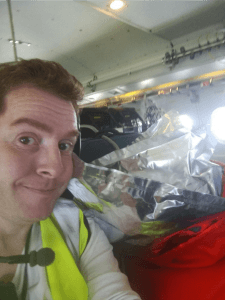Unlike quite a lot of the science on board the FAAM aircraft, the high precision carbon isotopes in methane have to be done back at the lab at Royal Holloway. To make this happen, we have to collect bags of air mid-flight as we pass over areas of interest, trying to capture the range of sources in the flight plan. However, it does mean that our role can look at little bit budget compared to the needs of a complex and expensive instrument rack measuring species in real-time during the flights.
The life of the isotope sampling team depends on your point of view… The instrument scientist who has to turn up 4 hours before take-off sees the isotope sampler swanning onto the aircraft at the last minute, switching on a pump and a laptop and writing some sticky labels. The logistics team who despair after each flight as we hand over a massive sack containing around 20 bags of air and ask them to find somewhere to store them and then ship them back home. The crew who just hear calls on the radio from the less technically named “bags”. Suggested nicknames which have fortunately not gained traction include “Team Bags”, “Dr Bag” and “Bag Man”…
I prefer to think us more of an Ngolo Kante or Anders Herrera (Ed – can we have a football reference in a science blog?). It’s not altogether obvious what we contribute until all the data is looked at, well after the campaign is done.
Collecting the air
It really is a simple as it sounds. The FAAM aircraft is fitted a large air inlet line which directs air from outside the aircraft to the various instruments, and the bag sampler has a pump which allows air from the outside to be directed in to the bags. The bags are made by SKC, and have been demonstrated in the laboratory to hold the methane without any leaks for months at a time, which gives us plenty of time to do the analysis. To show the full complexity of it, I agreed to do a special with plenty of detail for an upcoming edition of the Barometer podcast run by the University of Manchester.
In order for us to get useful data to identify the source we need to collect a suite of samples at as large a range of concentrations of methane as possible, fortunately the aircraft is well equipped and can measure atmospheric methane concentration in real-time. We use this information to try to sample the air into the bags at the most scientifically useful points.
Why are we interested?
As I’m sure you’ve read on many other posts on this blog and others, methane is rising globally and we’re not entirely sure why… One of the possible reasons is an increase in emissions from tropical wetlands, so we’re on this campaign to try and gather information needed such as the isotopic source signature and the flux of methane being emitted from tropical methane sources. There’s a lovely new paper (shameless plug) which has just been accepted which looks at the impact of methane globally “Very strong atmospheric methane growth in the four years 2014 – 2017: Implications for the Paris Agreement” which will be available in the journal Global Biogeochemical Cycles soon…
We’ll keep the blog updated with something later in the year, once the laboratory analysis has started to take shape.
by James France
On the aircraft, “Team Bags” is James France, Rebecca Fisher and Dave Lowry of Royal Holloway University Earth Science Department.
On the ground, a separate but co-ordinated with the aircraft, sampling campaign is ongoing with Tim Broderick, Trish Broderick and Dave Lowry.
